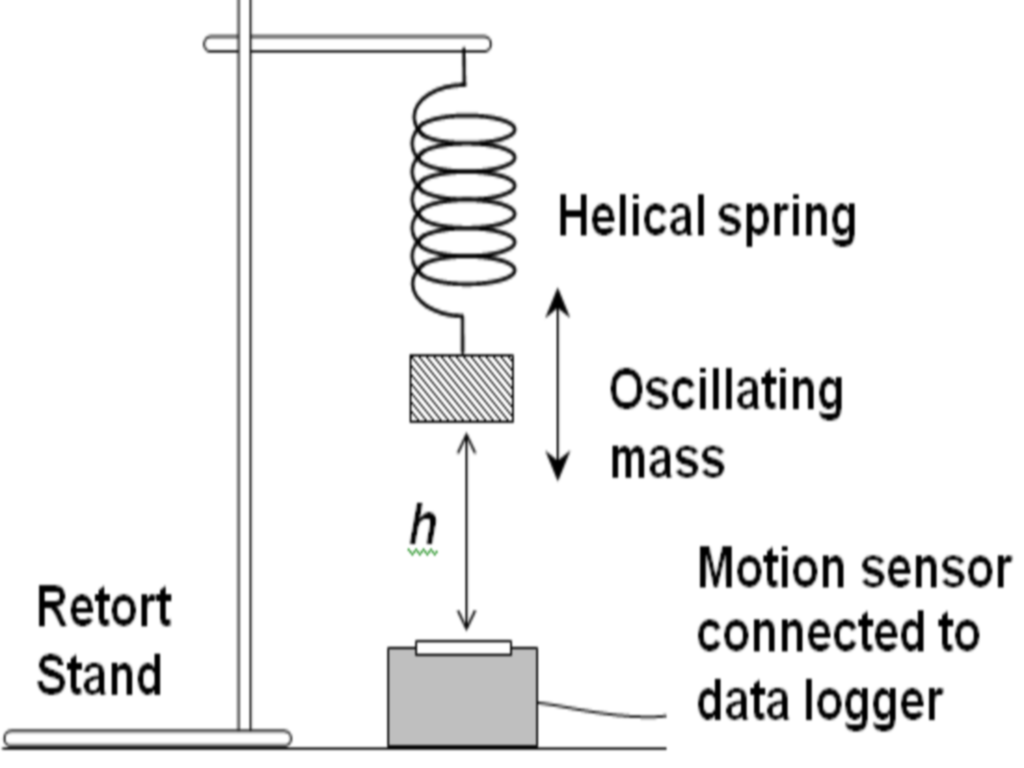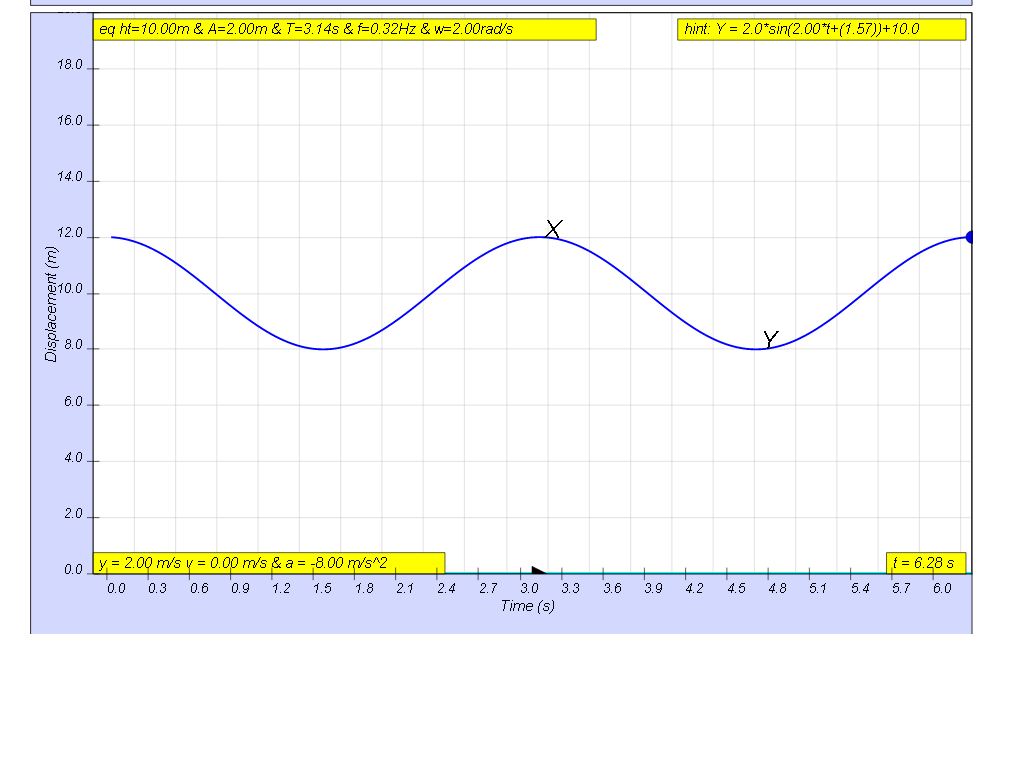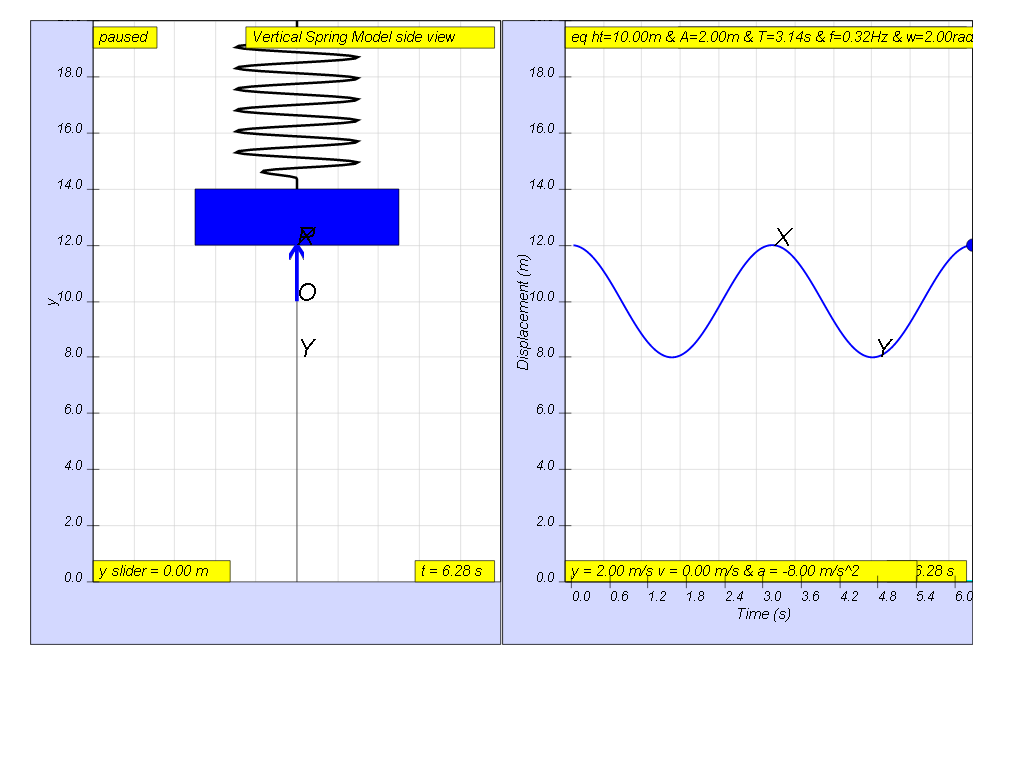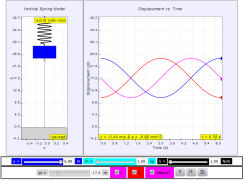About
1.2.13 Experimental Investigation of Vertical Oscillator LO (b)
Here is an illustration of how the oscillation of a basic spring-mass
system can be investigated using motion sensor.

- Setup the experiment as shown
- Displace the mass vertically downwards and release it with initial velocity =0 m/s so that it can oscillate freely in an up and down motion.
- Start the data logger when the oscillations are steady.
- The motion sensor detects the variation with time of height h.
Example of data collected is shown

Information of the oscillation can be drawn from Fig. 13.14 as follows:
- Equilibrium height h =
- Amplitude x0 =
- Period T =
- Frequency f =
- Angular frequency ω =
- Displacement when t = 5.7 s x =
[ 10.0 m , 2.0 m , 3.14 s , 0.32 Hz, 2.00 rad/s, +1.0 m)

1.2.13.1 Model:
Q1: setup the model to represent the conditions in the example hint:
select sensor?, y = 2.0m, k = 4 N/m etc.
Q2: setup the model with different conditions of your choice and recalculate the point 1 to 6.
Q3: a student suggests that the conditions of getting the same period of T = 3.14 s is to ensure the following equation is valid.
collect some data on your own, to verify this claim by this student. Suggest with reasons, whether the claim is supported by the evidences you can collect from the model.
Translations
| Code | Language | Translator | Run | |
|---|---|---|---|---|
 |
||||
Credits
 This email address is being protected from spambots. You need JavaScript enabled to view it.
This email address is being protected from spambots. You need JavaScript enabled to view it.
Briefing Document: Vertical Oscillator Model Investigation
1. Introduction
This document reviews a resource focused on the experimental investigation of a vertical oscillator model using a JavaScript HTML5 applet simulation. The resource is hosted by Open Educational Resources / Open Source Physics @ Singapore. This interactive model is designed for educational purposes, specifically targeting secondary and junior college levels. The primary goal is to allow students to explore the concepts of simple harmonic motion (SHM) and oscillations through hands-on simulation and data analysis.
2. Key Themes and Concepts
- Simple Harmonic Motion (SHM): The core theme revolves around understanding SHM, a specific type of oscillatory motion. The simulation provides a visual and interactive way to observe the behavior of a mass-spring system, a classic example of SHM.
- Vertical Oscillator: The simulation specifically models a vertical spring-mass system, which adds the complexity of gravity to the oscillating motion. This differs from horizontal systems, and the resource also offers other models like the horizontal spring mass model.
- Experimental Investigation: The resource emphasizes an experimental approach. Students are guided through a process similar to a real-world lab, where they:
- Set up the experiment (using the simulation).
- Displace the mass and observe its oscillation.
- Collect data on height (position) versus time.
- Analyze the data to determine key parameters of the oscillation.
- Interactive Simulation: The use of a JavaScript HTML5 applet allows for direct manipulation of parameters within the model. This is a departure from more static, text-based methods of instruction, enabling greater student engagement.
- Data Analysis: A core focus of the investigation is the analysis of the data generated by the simulation. Students are tasked with determining the equilibrium height, amplitude, period, frequency, angular frequency, and displacement at a given time from the simulated data. This encourages students to understand the relationships between these values and the motion itself.
- Verification of a Claim: A critical aspect of the learning process involves questioning. The resource prompts students to explore a student's claim regarding the relationship between mass (m), spring constant (k), and the period (T), and to verify this claim using the simulation. Specifically the student proposes that "m / k = 1 / 2" will always result in a T of 3.14 seconds.
3. Important Ideas and Facts
- Simulation Setup and Parameters: The simulation allows users to set initial conditions:
- Initial vertical position (y=2.0 m in the example)
- Spring constant (k = 4 N/m in the example). These values can be modified by the user in order to investigate the relationship between parameters and resulting oscillations.
- The simulation includes a sensor, which is used to output and analyze position versus time data.
- Example Data: The resource provides a set of example data drawn from one simulation of the model. The data includes the following measurements:
- Equilibrium height (10.0 m)
- Amplitude (2.0 m)
- Period (3.14 s)
- Frequency (0.32 Hz)
- Angular frequency (2.00 rad/s)
- Displacement at t=5.7 s (+1.0 m)
- Student Tasks: Students are prompted to use the simulation to:
- Replicate the provided example data.
- Explore the model under different conditions, recording the changes to the parameters.
- Investigate the relationship m/k and its effect on the period of the oscillation. The student's claim being that "*m / k = 1 / 2" will always result in a period of 3.14 seconds.
- Compare measured data with predictions that can be made based on the model.
- Applet Accessibility: The applet is designed to be accessible across multiple devices and platforms including "Android/iOS including handphones/Tablets/iPads" and "Windows/MacOSX/Linux including Laptops/Desktops" "ChromeBook Laptops" via web browser
- Other Resources: The resource is part of a larger collection of interactive simulations and learning tools, spanning a variety of physics and math concepts. The page lists numerous other models such as:
- Horizontal spring mass models.
- Pendulum models.
- Models covering kinematics, electromagnetism, optics, and more.
4. Key Quotes
- "Here is an illustration of how the oscillation of a basic spring-mass system can be investigated using motion sensor."
- "Displace the mass vertically downwards and release it with initial velocity =0 m/s so that it can oscillate freely in an up and down motion."
- "The motion sensor detects the variation with time of height h."
- "Q3: a student suggests that the conditions of getting the same period of T = 3.14 s is to ensure the following equation is valid. m k = 1 2 collect some data on your own, to verify this claim by this student."
5. Educational Significance
This resource leverages interactive simulation to:
- Enhance Understanding: Students learn through direct engagement, which deepens understanding of the underlying physics concepts and provides an intuitive grasp of the relationship between parameters and the motion.
- Promote Inquiry-Based Learning: The provided model encourages students to explore, ask questions, and test hypotheses rather than passively receiving information.
- Facilitate Experimentation: The simulation replaces the challenges of the traditional lab setting, allowing students to experiment without practical limitations.
- Develop Data Analysis Skills: The emphasis on collecting and interpreting data allows students to sharpen their analytic and critical thinking skills.
- Accessibility and Flexibility: The platform-agnostic nature of the HTML5 applet ensures that the simulation can be used widely in different learning environments.
6. Conclusion
The "Experimental Investigation of Vertical Oscillator Model" offers a valuable approach to teaching about simple harmonic motion. By integrating simulation, hands-on learning, and data analysis, it provides a powerful tool for conceptual understanding, and promotes critical thinking. This tool is part of a wider collection of resources that provide a valuable learning environment for physics and math students.
Vertical Oscillator Model Study Guide
Quiz
Instructions: Answer the following questions in 2-3 sentences each.
- What is the purpose of the motion sensor in the experimental setup described?
- In the context of this model, what does "equilibrium height" refer to?
- What are the standard units for measuring frequency and angular frequency, respectively?
- How is the period of oscillation (T) related to the frequency of oscillation (f)?
- What initial condition is set for the vertical displacement when the mass is released?
- In the simulation, how can the user adjust the conditions of the experiment?
- What does the value of "k" represent in the context of the spring-mass system and what units is it typically measured in?
- What is meant by the term "amplitude" in the context of oscillations?
- What does the student suggest is necessary to maintain a specific period of oscillation, and what mathematical relationship is proposed?
- Based on the text, what type of device is used to present the model/simulation?
Quiz Answer Key
- The motion sensor is used to detect and measure the variation of height (h) of the oscillating mass over time. This data helps analyze the oscillatory motion.
- Equilibrium height refers to the resting position or the average height of the mass when it is not oscillating. It's the center point around which the mass oscillates.
- Frequency is measured in Hertz (Hz), which represents cycles per second, while angular frequency is measured in radians per second (rad/s).
- The period (T) is the time for one complete oscillation, while the frequency (f) is the number of oscillations per second. They are inversely related, with the equation T=1/f.
- The mass is released with an initial velocity of 0 m/s, meaning it starts from rest at its initial displacement.
- Users can adjust the conditions by setting values for parameters such as the initial vertical displacement (y), spring constant (k), and mass (m).
- The value of "k" represents the spring constant, which is a measure of the spring's stiffness and is typically measured in Newtons per meter (N/m).
- Amplitude is the maximum displacement of the mass from its equilibrium position during an oscillation.
- The student suggests that the specific period is achieved when the square root of mass divided by the spring constant equals 1/2, expressed mathematically as √(m/k) = 1/2
- The model/simulation is presented using a JavaScript HTML5 Applet, which allows for interactive simulation within a webpage.
Essay Questions
Instructions: Answer the following questions using information from the provided source material. Develop well-structured essays that demonstrate your understanding of the vertical oscillator model and related concepts.
- Describe the experimental setup and procedure for investigating the vertical oscillator model, including the purpose and function of each component. How can this experiment be utilized to gather data regarding the oscillatory behavior?
- Explain the relationships between equilibrium height, amplitude, period, frequency, and angular frequency in the context of a simple harmonic oscillator. Use data and evidence from the example provided in the text to support your answer.
- Analyze the student's claim regarding the conditions required to achieve a specific period of oscillation (T = 3.14 s). What is the mathematical relationship suggested, and how would you experimentally verify or refute this claim using the provided model? Discuss the reasons for your conclusion.
- Discuss how the EasyJavaScriptSimulation model provides an effective way to explore the behavior of the vertical oscillator system. In what ways does using this simulation enhance understanding of abstract concepts such as simple harmonic motion? How does the interactivity promote learning?
- Considering the different models offered at the end of the resource, how does a vertical oscillator relate to other types of oscillator models like the horizontal spring mass model and the pendulum model?
Glossary of Key Terms
- Vertical Oscillator: A system where a mass oscillates vertically (up and down), typically connected to a spring or another restoring force.
- Motion Sensor: A device that detects and measures the movement of an object, in this context, the vertical movement of the oscillating mass.
- Equilibrium Height: The resting position or the average height of the oscillating mass when it is not in motion; the center point of oscillation.
- Amplitude (x0): The maximum displacement of the mass from its equilibrium position during an oscillation.
- Period (T): The time it takes for one complete cycle of oscillation.
- Frequency (f): The number of oscillations or cycles that occur per unit of time, typically measured in Hertz (Hz), cycles per second.
- Angular Frequency (ω): The rate of change of the angle of an oscillating object, measured in radians per second (rad/s); related to frequency by ω=2πf.
- Displacement (x): The distance of the mass from its equilibrium position at a given point in time.
- Spring Constant (k): A measure of the stiffness of a spring; the force required to stretch or compress it by a unit length, typically measured in Newtons per meter (N/m).
- Simple Harmonic Motion (SHM): A type of periodic motion where the restoring force is directly proportional to the displacement and acts in the opposite direction, often modeled by the motion of a spring-mass system or a pendulum.
- JavaScript HTML5 Applet: A small program embedded in a webpage that runs in a web browser, used to create interactive simulations.
Frequently Asked Questions about the Vertical Oscillator Simulation
- What is the purpose of the "Experimental Investigation of Vertical Oscillator Model Position y = 2" simulation?
- This simulation is designed to allow users to explore the behavior of a simple spring-mass system oscillating vertically. It's a virtual laboratory where you can set initial conditions, observe the motion, and collect data like displacement, amplitude, period, and frequency. The simulation aims to visually and interactively demonstrate concepts related to simple harmonic motion (SHM). It is intended to be used for experimentation in classrooms and at home.
- How does the simulation work, and what are the key parameters that can be adjusted?
- The simulation uses a JavaScript-based HTML5 applet to model a mass attached to a spring. Users can adjust parameters such as the initial vertical position (y), spring constant (k), and mass (m) of the object. They can then set the initial velocity to 0 m/s to initiate free oscillation. The simulation runs and outputs information which can be measured using a sensor that detects changes in the height of the mass over time. The simulation allows for the collection of experimental data of the oscillation, like equilibrium height, amplitude, period, frequency and angular frequency.
- What kind of data can be gathered from the simulation, and how can it be analyzed?
- The simulation allows the user to gather the following data: (1) equilibrium height (h), which is the resting position of the mass; (2) amplitude (x0), which is the maximum displacement from the equilibrium position; (3) period (T), which is the time for one complete oscillation; (4) frequency (f), which is the number of oscillations per second; (5) angular frequency (ω), related to the frequency by ω = 2πf; and (6) displacement (x) at a specific time (t). This data can be analyzed to understand the relationships between these variables and the system's behavior.
- What is the significance of setting the initial velocity to 0 m/s?
- Setting the initial velocity to 0 m/s means the user is not pushing or forcing the system into motion but is simply allowing it to move from a starting position. This ensures that the oscillation begins due to the restoring force of the spring alone and not due to an initial push. This is consistent with how the physical system would be setup when collecting real data.
- The simulation provides a specific example with parameter values and resulting data. How can users explore other scenarios?
The simulation encourages users to explore different scenarios by adjusting the values of initial displacement, spring constant (k), and mass (m) of the oscillating object. This allows for an experimental analysis of how different initial conditions influence the measured output data, like oscillation period, frequency, and amplitude. This is done by changing the simulation conditions and then re-running the simulation to observe the change in data outputs.
- A student proposes a relationship between mass, spring constant and period. How does the simulation allow for verification of the student's claim?
- The student suggested that a certain mathematical relationship between mass and spring constant must be valid to achieve a specific period (T=3.14s). The simulation allows users to test this claim by collecting data for multiple different combinations of mass and spring constant and analyzing the resulting periods. The users are encouraged to verify if the proposed mathematical relationship holds by comparing the simulation data and making a conclusion based on experimental evidence.
- What are the educational benefits of using this simulation?
- This simulation provides a hands-on way to visualize and understand the behavior of a simple harmonic oscillator. By manipulating variables and observing results, users can deepen their understanding of SHM concepts like period, frequency, amplitude, and the influence of mass and spring constant. It allows the user to use and collect data from the simulation just like in a lab with physical equipment, but with the freedom to test many different situations that may not be possible in the lab. It also provides a platform for testing scientific claims and gaining practical knowledge with a virtual experiment.
- What other kinds of interactive physics simulations are available on this platform?
- The platform offers a wide array of interactive physics simulations beyond just the vertical oscillator model. These include simulations related to horizontal spring-mass systems, pendulum motion, projectile motion, gravitational fields, collisions, and more. There are interactive simulations in other fields too like math and chemistry. The platform aims to provide a diverse set of tools for learning and exploration. The platform is designed for student learning space and includes a number of related resources.
- Details
- Parent Category: 02 Newtonian Mechanics
- Category: 09 Oscillations
- Hits: 6047







